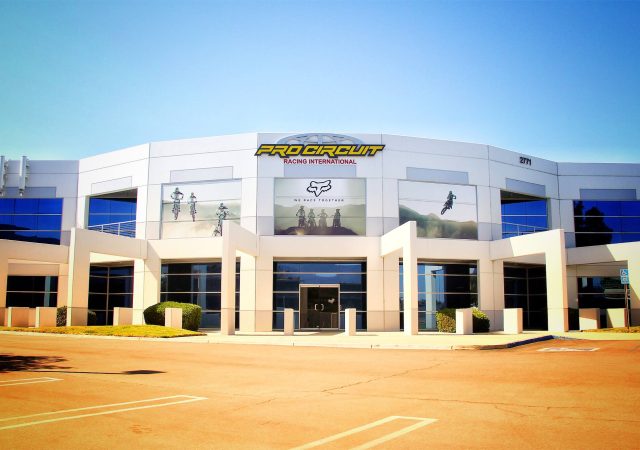
For this edition of Classic Ink, we are going to take a look back at some of Ceet Racing’s products from the 1980s and 1990s.
 My first recollection of Ceet Racing was as a provider of works-style “Safety Ceets” in the early eighties. At the time, only factory guys had trick “up-the-tank” seats that protected their family jewels, while the rest of us shlubs had to make do by cracking our nuts against the tank in turns. Ceet’s $29.95 (the equivalent of $111 in 2025 dollars) Safety Ceet provided an additional bit of foam padding to the front of the saddle and an all-new seat cover to protect the baby makers and give your new ’82 CR480R that factory look. For 49.95 ($185 today), Ceet would even provide you with a Complete Seat for your new steed. While the Safety Ceet was a great innovation and tremendous seller, most of the OEMs made it a superfluous addition by adding up-the-tank saddles as standard equipment within a few years.
My first recollection of Ceet Racing was as a provider of works-style “Safety Ceets” in the early eighties. At the time, only factory guys had trick “up-the-tank” seats that protected their family jewels, while the rest of us shlubs had to make do by cracking our nuts against the tank in turns. Ceet’s $29.95 (the equivalent of $111 in 2025 dollars) Safety Ceet provided an additional bit of foam padding to the front of the saddle and an all-new seat cover to protect the baby makers and give your new ’82 CR480R that factory look. For 49.95 ($185 today), Ceet would even provide you with a Complete Seat for your new steed. While the Safety Ceet was a great innovation and tremendous seller, most of the OEMs made it a superfluous addition by adding up-the-tank saddles as standard equipment within a few years.
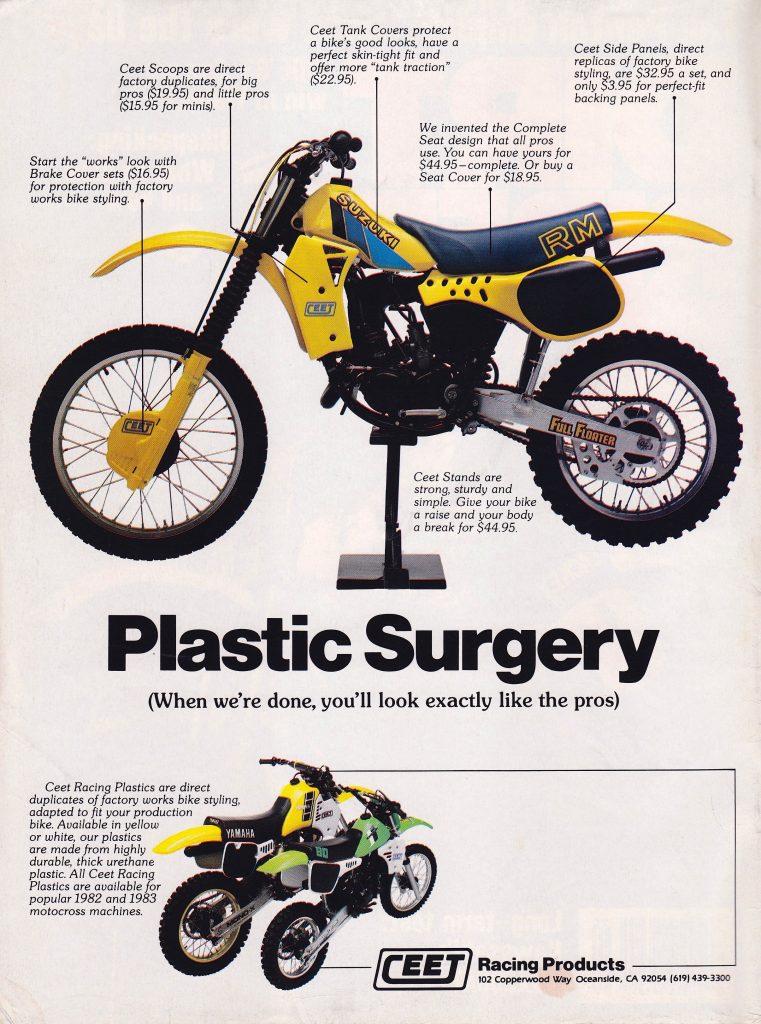 Today, Ceet Racing is mostly remembered for their seats and graphics, but they were also a popular provider of aftermarket plastic components in the early eighties. Works-style plastic brake covers, vented side plates that let in more air to the airbox, and restyled radiator scoops were all popular upgrades at the time.
Today, Ceet Racing is mostly remembered for their seats and graphics, but they were also a popular provider of aftermarket plastic components in the early eighties. Works-style plastic brake covers, vented side plates that let in more air to the airbox, and restyled radiator scoops were all popular upgrades at the time.
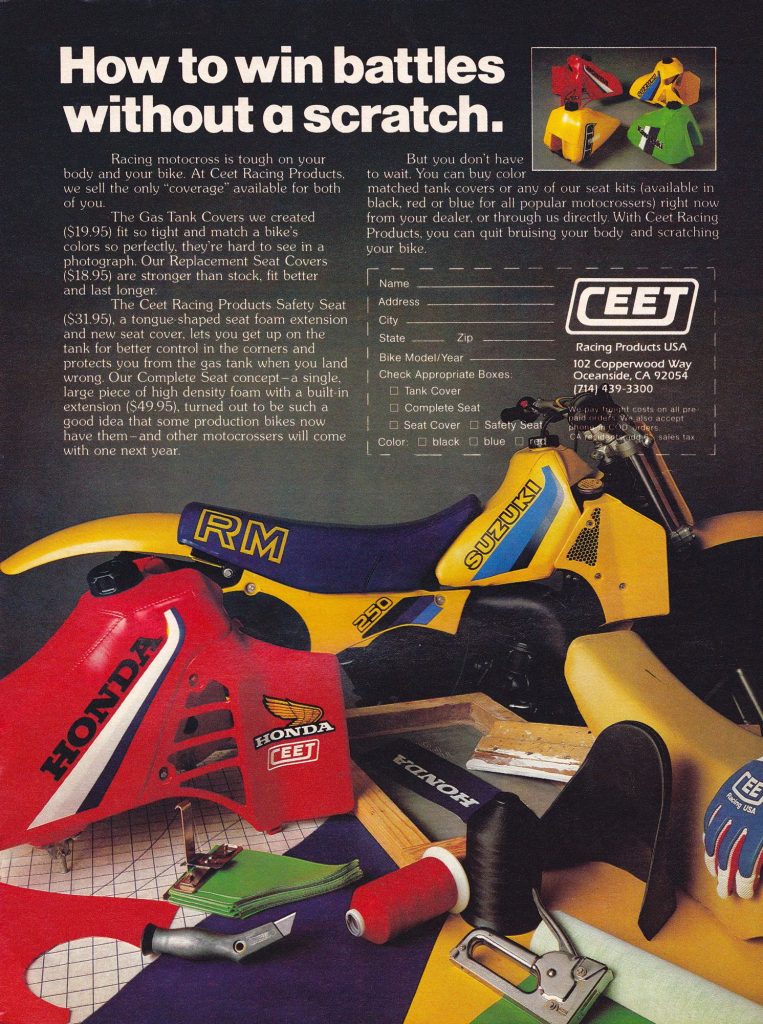 One of the side effects of the move to plastic tanks in the late seventies was the detrimental effect it had on decal life. The permeable plastic allowed gas fumes to weaken the glue holding them on, and most OEM graphics were long gone by the first top-end rebuild. Ceet’s answer to this was a vinyl cover that fit snuggly over the tank, mimicking the stock graphics and protecting the tank from damage. I bought one of these covers for my well-worn 1984 Yamaha IT200, and my only real complaint was that the blue of the vinyl cover did not quite match the baby blue of the rest of the IT’s plastic. Still, it did its job and looked better than a bald or decal-bubbled tank. Once the OEMs got smart and started putting the graphics on the radiator shrouds, it lessened the appeal of Ceet’s Gas Tank Cover, and they faded into moto obscurity by the mid-eighties.
One of the side effects of the move to plastic tanks in the late seventies was the detrimental effect it had on decal life. The permeable plastic allowed gas fumes to weaken the glue holding them on, and most OEM graphics were long gone by the first top-end rebuild. Ceet’s answer to this was a vinyl cover that fit snuggly over the tank, mimicking the stock graphics and protecting the tank from damage. I bought one of these covers for my well-worn 1984 Yamaha IT200, and my only real complaint was that the blue of the vinyl cover did not quite match the baby blue of the rest of the IT’s plastic. Still, it did its job and looked better than a bald or decal-bubbled tank. Once the OEMs got smart and started putting the graphics on the radiator shrouds, it lessened the appeal of Ceet’s Gas Tank Cover, and they faded into moto obscurity by the mid-eighties.
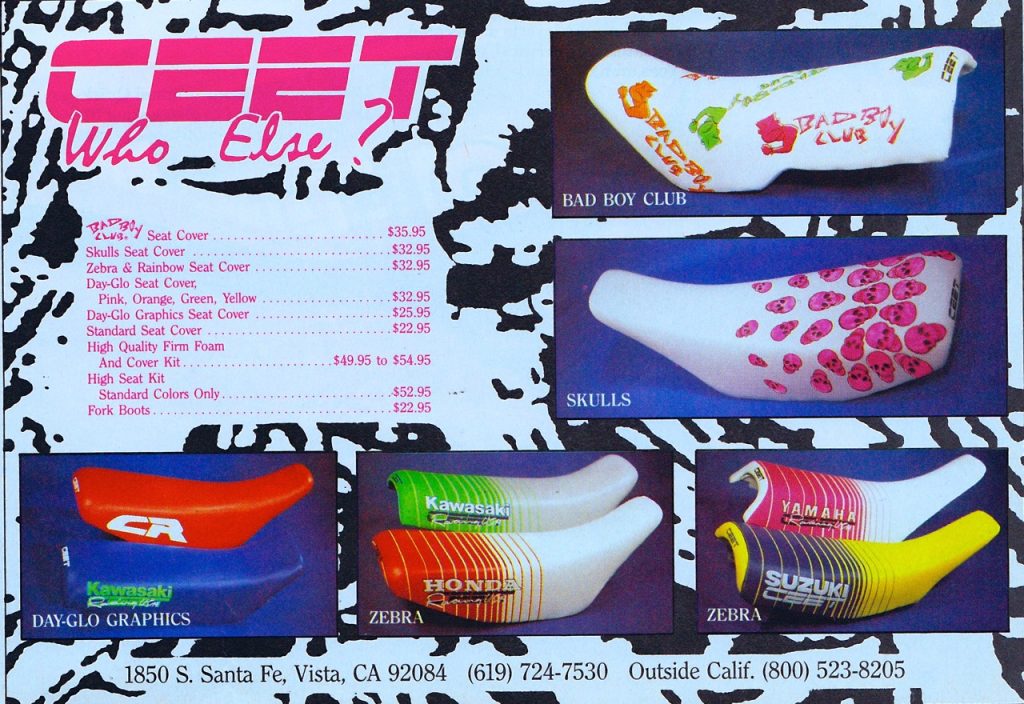 In 1988, apparel companies like JT Racing started to really push the fashion envelope with bold designs like their Dalmatian and Bad Bones lines. Ceet Racing was one of the first hard parts companies to capitalize on this shift in taste by bringing similarly bold designs to their accessory seat covers.
In 1988, apparel companies like JT Racing started to really push the fashion envelope with bold designs like their Dalmatian and Bad Bones lines. Ceet Racing was one of the first hard parts companies to capitalize on this shift in taste by bringing similarly bold designs to their accessory seat covers.
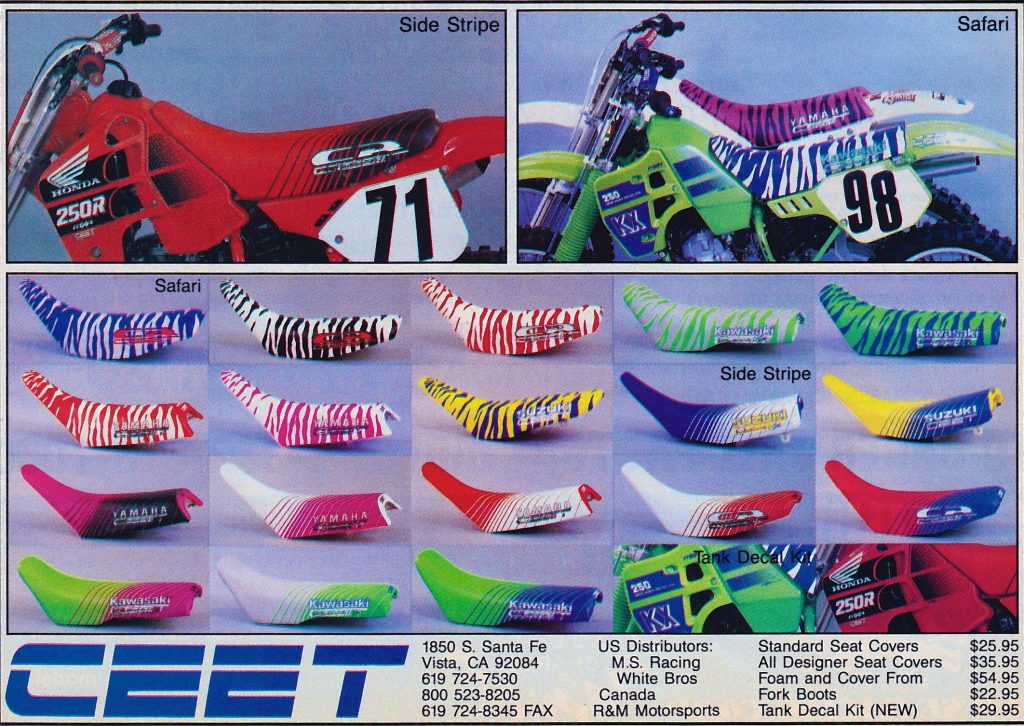 In my opinion, Ceet Racing’s big break into the moto mainstream came in 1989 with the arrival of their all-new Safari print covers. This coincided with the debut of Fox Racing’s groundbreaking Image line of gear, and the two were a perfect match for riders looking to be at the cutting edge of moto style. Man, that yellow and blue Safari is still fire in my opinion.
In my opinion, Ceet Racing’s big break into the moto mainstream came in 1989 with the arrival of their all-new Safari print covers. This coincided with the debut of Fox Racing’s groundbreaking Image line of gear, and the two were a perfect match for riders looking to be at the cutting edge of moto style. Man, that yellow and blue Safari is still fire in my opinion.
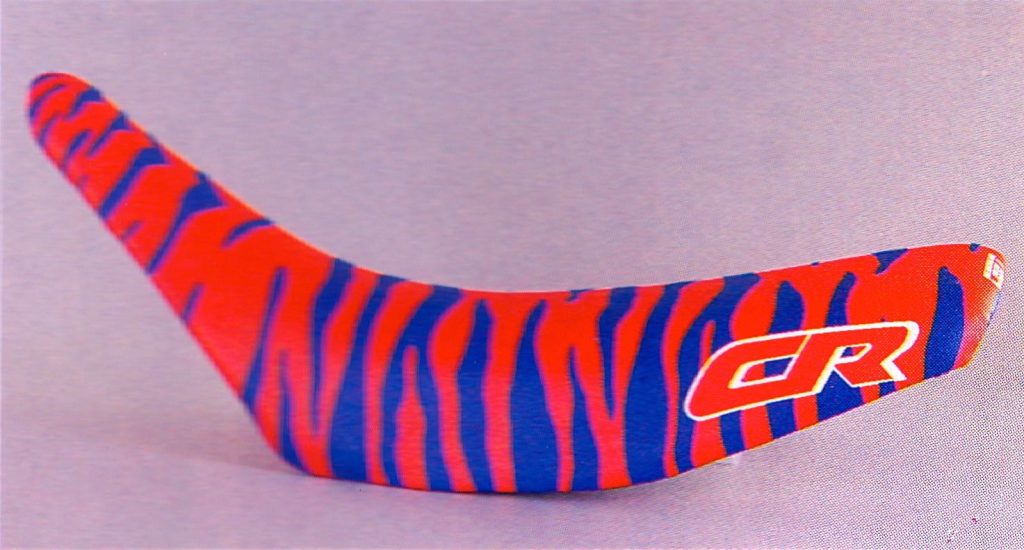 I absolutely LOVED this red and blue Safari Ceet, and I was obsessed with getting one for my CR125R until I witnessed how quickly the graphics wore off the red and white version my best buddy put on his XR250R. Such was the reality of late-eighties printing technology.
I absolutely LOVED this red and blue Safari Ceet, and I was obsessed with getting one for my CR125R until I witnessed how quickly the graphics wore off the red and white version my best buddy put on his XR250R. Such was the reality of late-eighties printing technology.
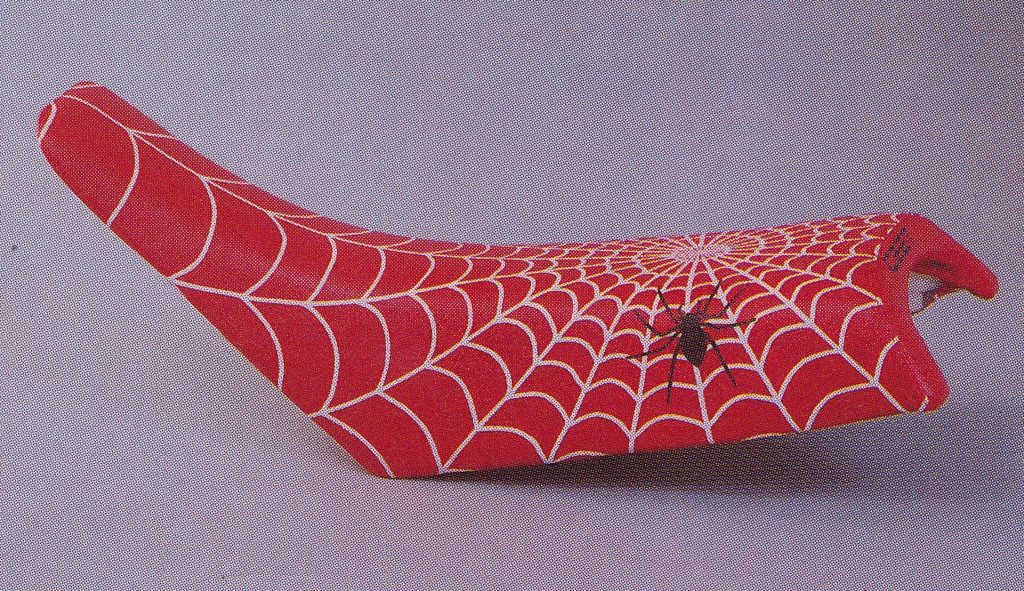 On the other hand, I was a hard pass on this Spiderman motif.
On the other hand, I was a hard pass on this Spiderman motif.
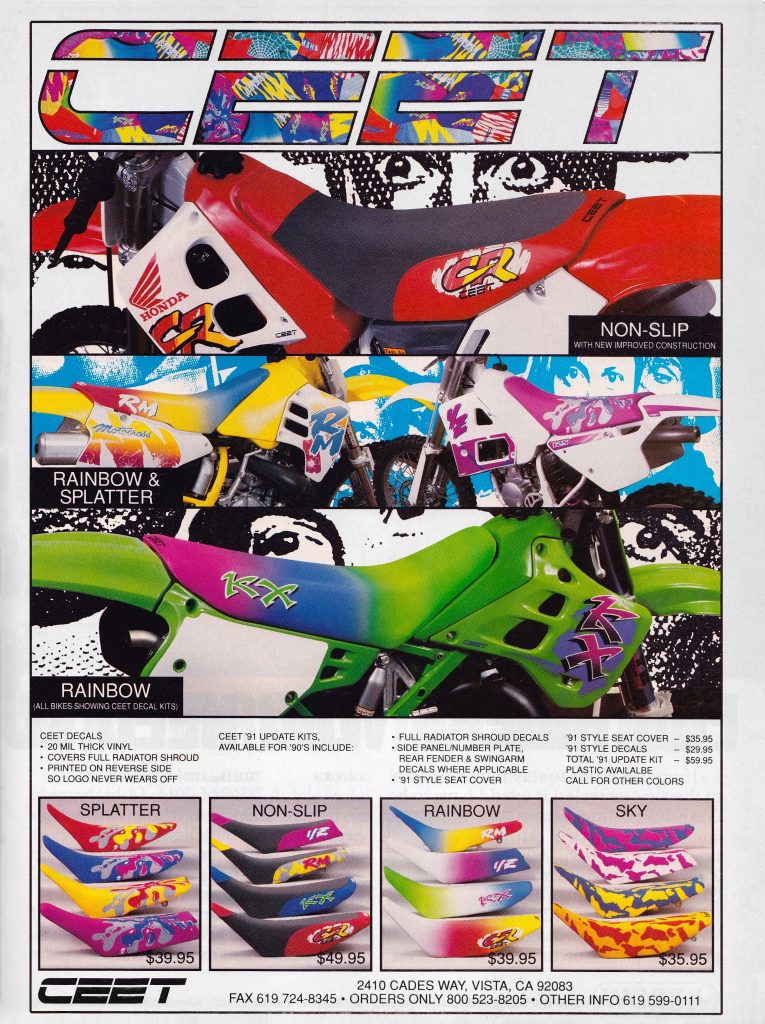 Ceet’s new “non-slip” covers were pretty unattractive in my opinion, but they did a great job of holding you in place. My buddy Jamie threw one of them on his YZ250, and it really made a difference under acceleration. Considering how slippery most seat covers were at the time, it was a real innovation in performance. In truth, I thought all of these 1991 Ceet designs were pretty ugly at the time, but if you wanted to give your Honda, Kawasaki, or Yamaha’s seat that lovely Suzuki “cat barf” look, then Ceet Racing had you covered.
Ceet’s new “non-slip” covers were pretty unattractive in my opinion, but they did a great job of holding you in place. My buddy Jamie threw one of them on his YZ250, and it really made a difference under acceleration. Considering how slippery most seat covers were at the time, it was a real innovation in performance. In truth, I thought all of these 1991 Ceet designs were pretty ugly at the time, but if you wanted to give your Honda, Kawasaki, or Yamaha’s seat that lovely Suzuki “cat barf” look, then Ceet Racing had you covered.
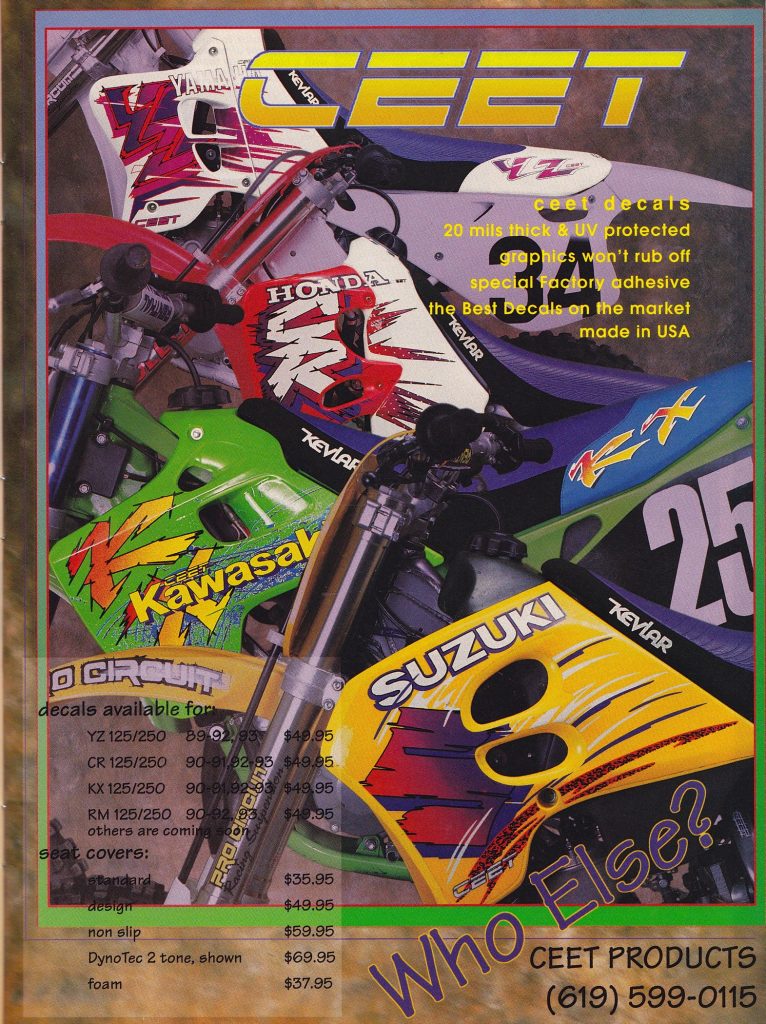 In the 1980s, aftermarket graphics were not much of a business, but improvements in processes and materials made them big business in the early 1990s. Ceet Racing, Factory Effex, N-Style, 100%, Tecnosel, and MXA (not the magazine) all became major players in this very competitive field. In my opinion, Ceet Racing never really hit the mark with any of their ’90s graphic designs, with the possible exception of this Suzuki design that looks a lot like a copy of Tecnosel’s Factory Suzuki graphics at the time. Regardless of my opinion on the matter, Ceet Racing sold a ton of these graphics to riders looking to make their steed stand out from the crowd.
In the 1980s, aftermarket graphics were not much of a business, but improvements in processes and materials made them big business in the early 1990s. Ceet Racing, Factory Effex, N-Style, 100%, Tecnosel, and MXA (not the magazine) all became major players in this very competitive field. In my opinion, Ceet Racing never really hit the mark with any of their ’90s graphic designs, with the possible exception of this Suzuki design that looks a lot like a copy of Tecnosel’s Factory Suzuki graphics at the time. Regardless of my opinion on the matter, Ceet Racing sold a ton of these graphics to riders looking to make their steed stand out from the crowd.
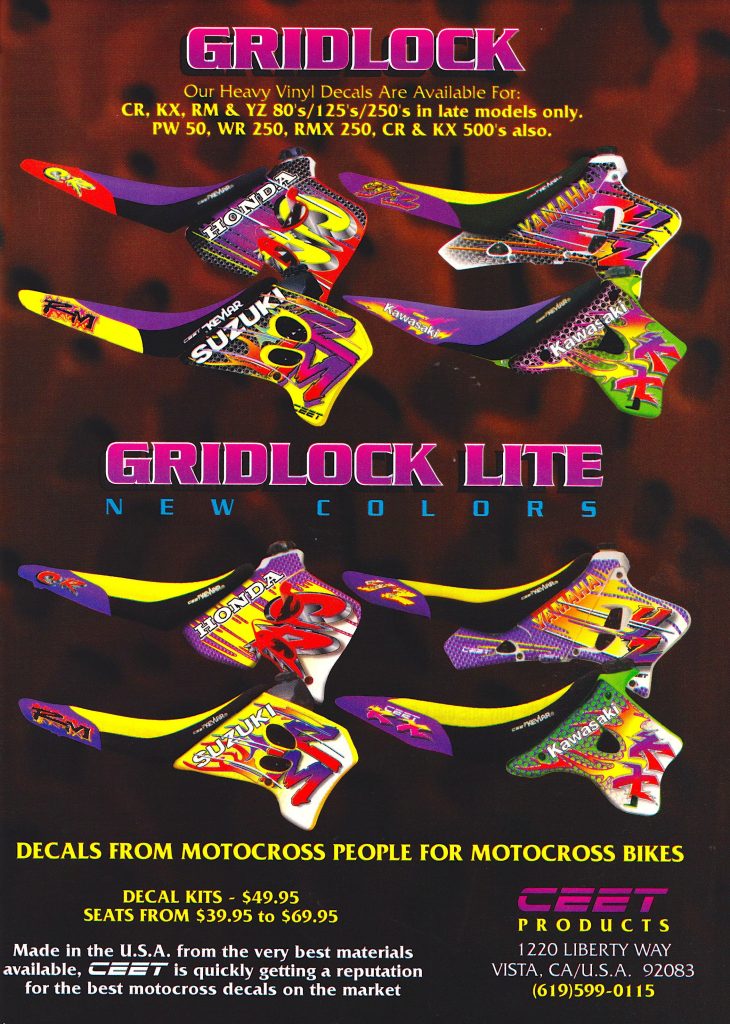 Ceet’s new Gridlock line for 1994 was certainly bright and bold. It was not to my liking at the time, but I saw plenty of them on bikes at the races back then. Ceet added Kevlar to the front section of their seat covers in the mid-nineties. It was a nice addition for knee brace wearers. Adding color to the non-slip covers also helped the appearance of the covers greatly.
Ceet’s new Gridlock line for 1994 was certainly bright and bold. It was not to my liking at the time, but I saw plenty of them on bikes at the races back then. Ceet added Kevlar to the front section of their seat covers in the mid-nineties. It was a nice addition for knee brace wearers. Adding color to the non-slip covers also helped the appearance of the covers greatly.
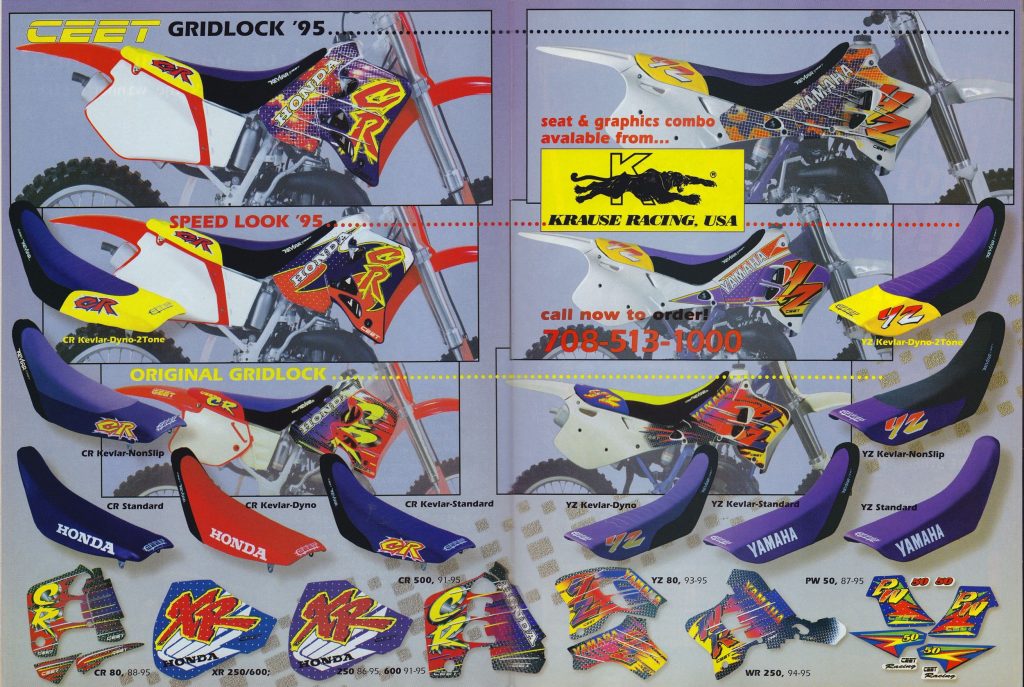 The early to mid-nineties were Moto’s purple period, and Ceet Racing had your purple fetish covered in 1995.
The early to mid-nineties were Moto’s purple period, and Ceet Racing had your purple fetish covered in 1995.
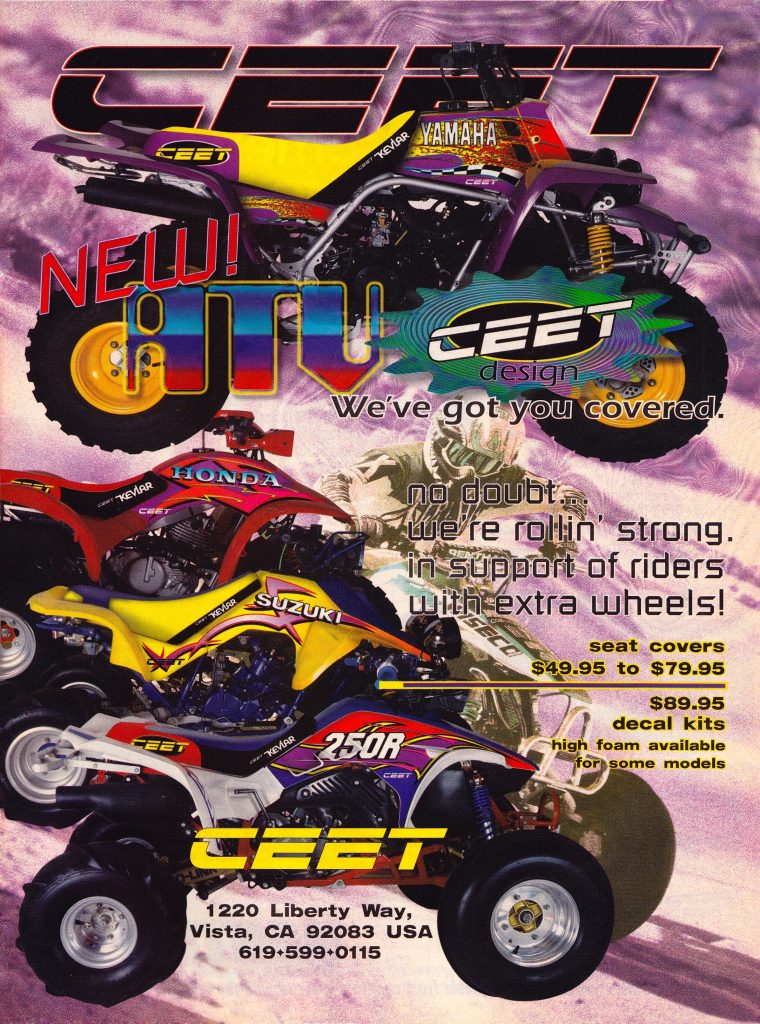 The performance ATV market was in a dark place in 1995 with the retirement of every machine but the ageless Yamaha Banshee. Regardless of the OEM’s lack of enthusiasm, there were still a ton of Honda 250Rs and Suzuki Quadracers in the wild looking for a graphical refresh that Ceet was more than happy to provide.
The performance ATV market was in a dark place in 1995 with the retirement of every machine but the ageless Yamaha Banshee. Regardless of the OEM’s lack of enthusiasm, there were still a ton of Honda 250Rs and Suzuki Quadracers in the wild looking for a graphical refresh that Ceet was more than happy to provide.



